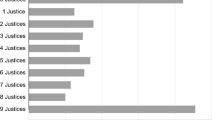Conclusion
The major conclusion to be drawn from this analysis is that low-cost suppliers of political favors receive the highest honoraria incomes. There is no evidence that being a lawyer, acquiring a large number of committee assignments, receiving high ratings by labor unions, representing a safe district, or introducing numerous legislative bills, increases one's honoraria income in any significant way. The wider dispersal of power reduces the effects of seniority, and membership on the Finance Committee, in determining institutional power in the Senate; hence, these variables are only significantly related to honoraria income in the House. The smaller the number of suppliers in the Senate, relative to the House, means that senators obtain higher prices for their services. As a result, business groups are more willing to pay extra — a price premium — to assure that no shirking occurs.
While the distribution of honoraria has caused considerable concern and given rise to cynical explanations as to who gets them and why (see, for example, McChesney, 1987), this analysis suggests a less pejorative but empirically valid conclusion: business, and therefore honoraria, gravitate to those who can supply political favors at a lower cost than other legislators, just as low-cost suppliers gain a greater proportion of the sales in the market than those who supply the same service but at a higher price.
Similar content being viewed by others
References
Congressional Quarterly Weekly Report, 2 June, 1990: 1749–1753.
Downs, A. (1957). An economic theory of democracy. New York: Harper and Row.
Fiorina, M.P. (1977). Congress: Keystone of the Washington establishment. New Haven, CT: Yale University Press.
Gopoian, J.D. (1984). What makes PACs tick?: An analysis of the allocation patterns of economic interest groups. American Journal of Political Science 28 (May): 259–281.
Kalt, J. and Zupan, M. (1984). Capture and ideology in the economic theory of politics. American Economic Review (June): 279–300.
Klein, E. and Leffler, K.B. (1981). The role of market forces in assuring contractual performance. Journal of Political Economy 89 (February–August): 615–641.
Landes, W. and Posner, R.A. (1975). The independent judiciary in an interest-group perspective. Journal of Law and Economics 18 (December): 875–901.
Lott, J.R. (1987). Political Cheating. Public Choice 52 (February): 169–185.
McChesney, F.S. (1987). Rent extraction and rent creation in the economic theory of regulation. Journal of Legal Studies 16 (January): 101–118.
McCormick, R.E. and Tollison, R.D. (1981). Politicians, legislation, and the economy. Boston: Martinus Nijhoff.
Munger, M. (1989). A simple test of the thesis that committee jurisdictions shape corporate PAC contributions. Public Choice 62: 181–186.
Olson, M. (1965). The logic of collective action. Cambridge, MA: Harvard University Press.
Posner, R.A. (1974). Theories of economic regulation. Bell Journal of Economics and Management Science 5 (Autumn): 335–358.
Poole, K. and Romer, T. (1985). Patterns of political committee contributions to the 1980 campaigns for the U.S. House of Representatives. Public Choice 47: 63–111.
Shepsle, K.A. and Weingast, B.R. (1987). The institutional foundations of committee power. American Political Science Review 81 (March): 85–104.
Stigler, G.J. (1971). The theory of economic regulation. Bell Journal of Economics and Management Science 2 (Spring): 3–21.
Tollison, R.D. (1988). Public choice and legislation. Virginia Law Review 74 (March): 339–371.
Tollison, R.D. (1982). Rent-seeking: A survey. Kyklos 35: 575–601.
Tullock, G. (1967). The welfare costs of tariffs, monopolies, and theft. Western Economic Journal 5: 224–232.
Author information
Authors and Affiliations
Rights and permissions
About this article
Cite this article
Parker, G.R. The distribution of honoraria income in the U.S. Congress: Who gets rents in legislatures and why?. Public Choice 73, 167–181 (1992). https://doi.org/10.1007/BF00145090
Received:
Accepted:
Issue Date:
DOI: https://doi.org/10.1007/BF00145090




